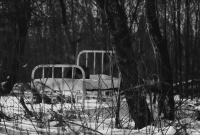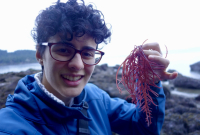Thank you for helping us meet our fundraising goal!
It’s a common story, retold again and again: horses didn’t exist on Turtle Island until European contact, when the Spaniards brought them over. The animals escaped domestication in South America, travelling north up the Great Plains, and eventually became wild mustangs.
The only problem is that the story isn’t true.
There are horses native to Turtle Island, though they became endangered after European contact, their numbers reduced to only four mares before a group of Ojibwe men saved them. Those horses, which lived in the boreal forest of Ontario and the northern Midwest in the United States, are called Ojibwe spirit horses.
They are still endangered, with approximately only 150 in existence today. Eight of these horses are housed on Mādahòkì Farm, a tourism and events destination run by Indigenous Experiences, where they are a living representation of the farm’s larger work of reclamation, education and celebration of Indigenous cultures and traditions.
“You’re never going to find a better example of reconciliation than those horses,” Maggie Downer, cultural ambassador and organizer of the equine assisted learning program at Mādahòki Farm, told Canada’s National Observer.

The farm is saving and reclaiming the Ojibwe spirit horses, which Downer says were almost extinct after colonization. The horses were never domesticated; they were considered pests to many settlers who would have had larger, domesticated breeds, Downer says, and they are part of a larger history of Indigenous Peoples pre-contact that was almost erased.
But now the horses are an active attraction for the farm and an emblematic lesson on the history of colonization for Indigenous and non-Indigenous people alike.
The point is captured by the name Mādahòki, Anishinaabe for “sharing the land.” Its welcome environment speaks to the educational and cultural hub Mādahòki has become since opening last October.
The farm emerged after Trina Mather-Simard, director of Indigenous Experiences, heard about the story of the Ojibwe spirit horses on the radio from artist Rhonda Snow.
Snow paints pictures of the spirit horses, among other subjects, in the woodlands style popularized by Norval Morrisseau and other Anishinaabe artists.

“She was talking about the Ojibwe spirit ponies, and my mind was blown,” she says. “I’m Ojibwe myself and my daughters are equestrians, and I had never heard of them.”
After the worst of the COVID-19 pandemic subsided, Mather-Simard and her daughters purchased four of the horses.
It was perfect timing for Indigenous Experiences. The company had just lost its cultural space — a tipi village opened seasonally on Victoria Island near downtown Ottawa — and moved into the Canadian Museum of History across the river in Quebec.
A space opened up in the greenbelt that was the perfect solution: 164 acres of land allowed the company to expand from cultural programming to a lands-based educational model.
At the farm, there are garden beds filled with tobacco and the Anishinaabe three sisters (beans, corn and squash grown in unison), plus a nature trail with information on native plant species and medicines and lined with reconciliation stones from visitors and Elders.

The location also serves as a festival grounds. It hosted a summer solstice Indigenous festival on National Indigenous Peoples Day on June 21.
There’s also a shop filled with the work of Indigenous artists, artisans and chefs, including traditional Indigenous foods like bison and candied Arctic char.
Long term, Mather-Simard hopes to build fenced-in trails for the Ojibwe spirit horses to simulate a wild habitat. The farm is also hoping to create enclosures to host bison and caribou in order to provide a hub for traditional foods to Indigenous Peoples in the area.
Mādahòkì Farm hosts programming initiatives for Indigenous communities and youth.

On Aug. 15, the farm launched Indigenous Foodways. It is an eight-week culinary training program for Indigenous youth aimed at teaching professional culinary skills to those hoping to work in Indigenous food services. Participants will learn foraging, fishing, planting and traditional food preparation and production.
The farm also has an equine assisted learning (EAL) program run by Downer, who is Haudenosaunee from Thayendanegea, and her assistant Charlotte Smith, a non-Indigenous equestrian. The program teaches boundaries and confidence, and provides therapy to participants but with a twist: its curriculum is Indigenized to model the Anishinaabe Seven Grandfather teachings and provide cultural sensitivity to Indigenous participants. The farm has already worked with at-risk youth, and Downer, who has a background in social services, hopes to expand that work.
Smith, who has worked in professional western horsemanship her whole life, says it’s a relief to learn a decolonized understanding of the art.
It’s the reason why the farm’s Indigenized EAL model isn’t based on objectives but instead focused on healing and partnership.
“It’s surrounding ourselves around healthy living, that we all live in partnership,” Downer says.
“Nowadays, we hear about the sacred circle. In the city, we sometimes forget it’s not just people living in that circle: our animals, our winged [animals], even our plants, and to see that full picture — while including our horses — as not tools to be used, but as teachers.”
Matteo Cimellaro / Local Journalism Initiative / Canada’s National Observer







Comments